El día comienza muy temprano para poder aprovecharlo al máximo. esta vez, toca ganarle la carrera a la salida del sol y llegar a la fábrica entre la neblina y el respectivo exceso de amor de Boss, mi compañero canino de aventuras cerveceras.
The day starts very early to make the most of it. This time, it's time to beat the sunrise and get to the factory amidst the fog and the respective excess of love from Boss, my canine companion of brewing adventures.


Lo primero que hago es revisar que todos los equipos se encuentren disponibles y limpios, en la elaboración de productos es muy importante la esterilización y la higiene durante los procesos, ya que cualquier contaminación nos afectaría todo el día de trabajo, y eso no es divertido.
Luego de esto, comienza la acción. así que les presentaré a los protagonistas de esta historia:
The first thing I do is to check that all the equipment is available and clean. In the elaboration of products, sterilization and hygiene during the processes are very important, since any contamination would affect the whole working day, and that is not fun.
After this, the action begins. so I will introduce you to the main characters of this story:
El Agua: La cerveza es aproximadamente un 90% agua así que es lo primero que debemos cuidar y tener en cuenta al momento de la preparación, para esto, utilizo un agua que pasa por filtros de carbono, activado e intercambio iónico, que ayudarán a tener un agua con las características que se necesitan. Hoy, elaboraré una cerveza color ámbar basada en el estilo Pale Ale; Además de ser una de mis favoritas, le va muy bien el perfil que puedo obtener del agua que tengo a disposición. Después de confirmar los valores de minerales presentes en ella, es momento de llenar la primera olla, donde encenderemos un quemador a gas para aumentar la temperatura.
Water: Beer is approximately 90% water, so it is the first thing we must take care of and take into account at the time of preparation, for this, I use water that passes through carbon, activated and ion exchange filters, which will help to have water with the characteristics that are needed. Today, I will brew an amber-colored beer based on the Pale Ale style; besides being one of my favorites, the profile I can obtain from the water I have available suits it very well. After confirming the mineral values present in it, it is time to fill the first pot, where we will turn on a gas burner to increase the temperature.
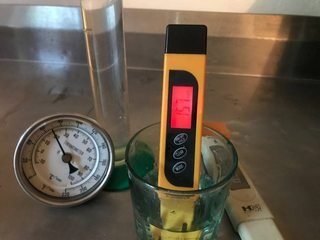
Cebada Malteada: Existen muchos tipos de cebada malteada, cada uno es tratado por empresas productoras utilizando diferentes parámetros para así obtener diferentes resultados, partiendo de una cebada muy clara hasta una casi rostizada. La utilizacion de estos, nos darán características específicas, en nuestro producto final, así que lo divertido es jugar con ellas para obtener lo que buscamos. Los granos de la cebada malteada son los que nos darán el color y parte del sabor para nuestra cerveza, como quiero obtener una cerveza color ámbar necesitaré una combinacion de tipos de cebada que lo logren.
Malted Barley: There are many types of malted barley, each one is treated by companies using different parameters to obtain different results, from very clear barley to an almost roasted one. The use of these will give us specific characteristics in our final product, so the fun is to play with them to get what we are looking for. The grains of the malted barley are the ones that will give us the color and part of the flavor for our beer, as I want to obtain an amber-colored beer I will need a combination of barley types that will achieve it.
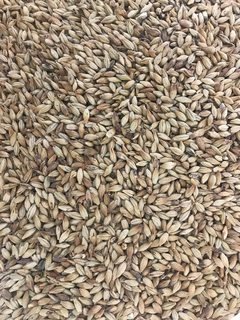
Lúpulo: El sensual y mágico Lúpulo. Es la flor de una planta perteneciente a la familia Humulus, la cual, según su zona de cosecha, año y demás composiciones, cumple el papel de darle el carácter a nuestro producto, el lúpulo es el principal actor al momento de darle amargor, sabor y aroma a la cerveza. Puede venir en flor o en pellets para su mejor exportación manejo y almacenaje.
Hops: The sensual and magical hops. It is the flower of a plant belonging to the Humulus family, which, according to its harvest area, year, and other compositions, plays the role of giving character to our product. Hops are the main actor in the moment of giving bitterness, flavor, and aroma to the beer. It can come in flowers or pellets for better export, handling, and storage.
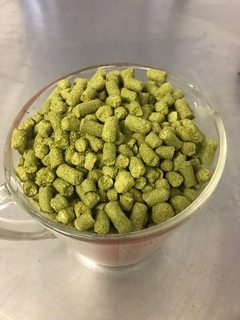
Levadura: La verdadera creadora, materializadora del amor y de la justicia cervecera, es la levadura! Ya que ella es quien convierte nuestra preparación en cerveza. Existen muchos tipos de levadura y cada una ayudará en proporción a la creación de la cerveza.
Yeast: The true creator, the materializer of love and brewing justice, is the yeast! For it is the yeast that turns our brew into beer. There are many types of yeast and each one will help in proportion to the creation of beer.
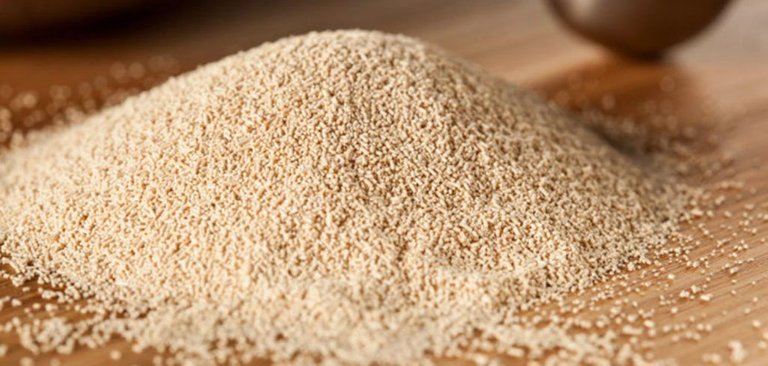
Fuente
Corazón: Como en todo proceso culinario y de la vida, tenemos que tener buena actitud y energía positiva al momento de cocinar nuestra cerveza, este ingrediente le da ese toque anímico a nuestra creación!
Listos los ingredientes, ahora vamos a Cocinar!
La cebada malteada, contiene en su interior una cantidad de almidón que necesitamos extraer cuando entre en contacto con el agua, así que debemos molerlo para poder exponer su interior, lo ideal es tener un molino que pueda partir el grano a la mitad, no debe quedar pulverizado ya que su cáscara nos ayudará también en el proceso. Como quiero hacer una cerveza color ámbar en base al estilo Pale Ale, busco información sobre su perfil en la BJCP y tras conocerlos, voy al programa que utilizo para elaborar recetas y ahí diseño lo que será la cocción del día. Para realizarla necesito una malta base y una malta que me aporte algo del dulzor y ese color que quiero, las indicadas son malta Pilsen y malta Crystal, pertenecientes a la empresa Castle Malting en Belgica la cual es importada por un par de cervecerías grandes acá en Venezuela.
Heart: As in every culinary and life process, we have to have a good attitude and positive energy when cooking our beer, this ingredient gives the right touch to our creation!
Ingredients ready, now let's get cooking!
The malted barley contains in its interior an amount of starch that we need to extract when it comes in contact with water, so we must grind it to expose its interior, the ideal is to have a mill that can split the grain in half, it should not be pulverized because its shell will also help us in the process. As I want to make an amber-colored beer based on the Pale Ale style, I look for information about its profile in the BJCP and after getting to know them, I go to the program I use to elaborate recipes and there I design what will be the brew of the day. To make it I need a base malt and a malt that gives me some of the sweetness and color I want, the indicated ones are Pilsen malt and Crystal malt, belonging to the company Castle Malting in Belgium which is imported by a couple of large breweries here in Venezuela.
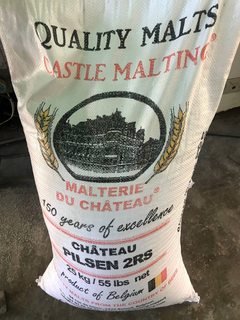
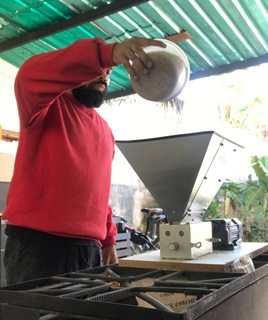

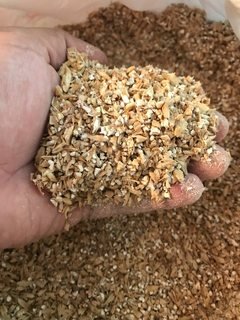
Después de conocer las cantidades y tener todos los granos molidos, hay que verificar que la temperatura del agua sea la correcta al igual que su litraje en proporción al grano que vamos a usar, en esta cocción tendrá una relación de 3 litros por cada kilo de cebada. Como debemos extraer el almidón y darle color a nuestra cerveza, la temperatura a la que realizaremos este macerado estará entre los 65 y 68 grados Celsius. En el fondo de la olla se encuentra un falso fondo que tiene pequeños orificios en su superficie para que solo circule el líquido y el grano quede sobre él, adicional a esto, suelo colocar una malla protectora previamente esterilizada para contener el grano dentro de la olla y así estar muy seguro de que solo circule líquido durante este proceso. Espero a que la temperatura del agua llegue a unos 71 grados y comienzo a lanzar el grano previamente molido, removiendo suavemente para que no se formen grumos y como el grano está a temperatura ambiente (unos 20 grados Celsius aproximadamente) al momento de mezclarse con el agua, la temperatura va a disminuir a unos 67/68 grados. La temperatura es muy importante, ya que la necesitamos para que las partículas de almidón se conviertan en azúcares fermentables y para obtener el color que buscamos, para ello, recirculo en la olla y sobre el grano, el líquido que ahora llamaremos mosto, durante una hora para homogenizar la temperatura y para que las cáscaras del grano lo filtren y me dé un mosto más cristalino y sensual.
After knowing the quantities and having all the grains milled, it is necessary to verify that the temperature of the water is the correct one as well as its liters in proportion to the grain that we are going to use, in this cooking it will have a relation of 3 liters for each kilo of barley. As we must extract the starch and give color to our beer, the temperature at which we will carry out this mashing will be between 65 and 68 degrees Celsius. In the bottom of the pot, there is a false bottom that has small holes in its surface so that only the liquid circulates and the grain remains on it, in addition to this, I usually place a protective mesh previously sterilized to contain the grain inside the pot and thus be very sure that only liquid circulates during this process. I wait for the water temperature to reach about 71 degrees and start throwing the previously ground grain, stirring gently so that no lumps are formed and as the grain is at room temperature (about 20 degrees Celsius approximately) at the time of mixing with water, the temperature will decrease to about 67.68 degrees. The temperature is very important since we need it so that the starch particles become fermentable sugars and to obtain the color we are looking for, for this, I recirculate in the pot and on the grain, the liquid that now we will call must, during one hour to homogenize the temperature and so that the grain shells filter it and give me a more crystalline and sensual must.
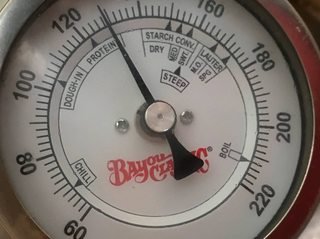
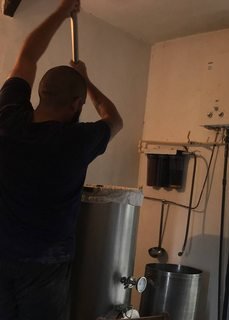
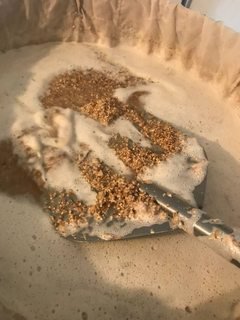
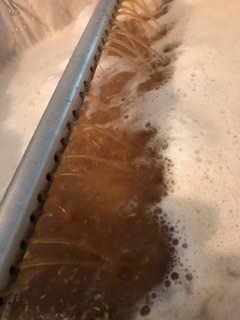
Al transcurrir una hora, en la cual el olor a pan invade la cervecería, el almidón ahora es azúcar y el mosto tiene un hermoso color ámbar gracias a la malta Crystal. Es momento de pasarla a una segunda olla donde lo llevaremos a su punto de ebullición para esterilizar el mosto y tener todo listo para darle nuestro toque agregándole el hermoso lúpulo del amor y de la justicia!
After an hour, in which the smell of bread invades the brewery, the starch is now sugar and the wort has a beautiful amber color thanks to the Crystal malt. It is time to transfer it to a second pot where we will bring it to a boil to sterilize the wort and have everything ready to give it our touch by adding the beautiful hops of love and justice!

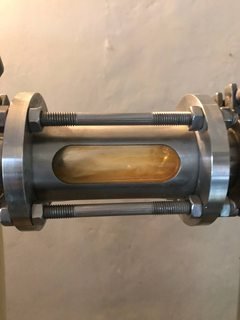
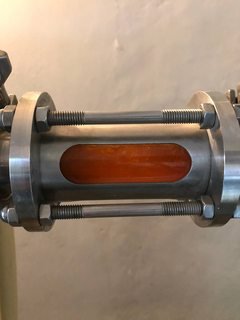
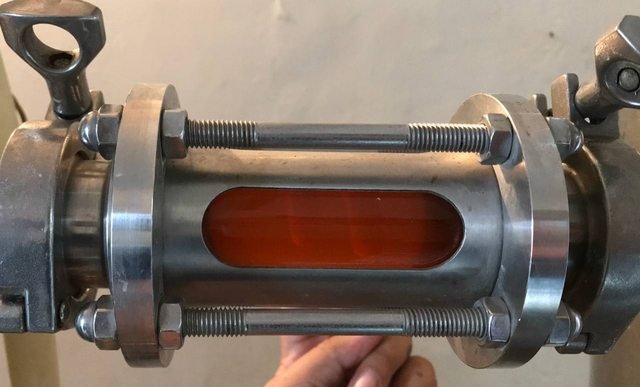
Para esta cocción utilizaré dos tipos de lúpulos: uno de origen Alemán llamado Mandarina Bavaria y otro llamado Mount hood cosechado en Estados Unidos. Cada uno le aportará características especiales a la preparación, y aquí es donde la imaginación vuela y diseñamos la intención de la cerveza basándonos en los tiempos de adición al mosto, cantidades y tipo de lúpulos. Basicamente , el lúpulo es como el cilantro en una sopa, sí lo exponemos durante una hora hirviendo en el mosto, se evaporan los aceites en enzimas que este contiene y quedará en su estado más básico aportando amargor, en cambio, si lo coloco a unos 30 minutos en el hervor, el lúpulo podrá aportar sabor al líquido, y si lo coloco al final del hervor, entre unos 5 a 0 minutos antes de apagar el quemador, podrá incorporar al mosto, aromas sensuales (como el cilantro en una buena sopa recién servida).
For this brew I will use two types of hops: one of German origin called Mandarina Bavaria and another one called Mount hood harvested in the United States. Each one will bring special characteristics to the brew, and this is where the imagination flies and we design the intention of the beer based on the times of addition to the wort, quantities, and type of hops. Hops are like coriander in a soup, if we expose it for an hour boiling in the wort, the oils and enzymes it contains evaporate and it will remain in its most basic state providing bitterness, on the other hand, if I place it about 30 minutes in the boil, the hops can provide flavor to the liquid, and if I place it at the end of the boil, between 5 to 0 minutes before flameout, it can incorporate sensual aromas to the wort (like coriander in a good freshly served soup).

Es por esto que combino las características de los lúpulos para obtener el perfil que deseo: Una cerveza con un amargor respetable más no invasivo, con notas a mandarina y aroma cítrico, herbal, frutal.
Pasada la hora de hervor del mosto con sus respectivas adiciones de lúpulos, hay que enviarlo a un fermentador para poderle agregar la levadura y que esta haga la magia de crear la cerveza. Nosotros diseñamos el perfil, el contexto necesario e ideal para que la levadura haga su trabajo de amor, pero las levaduras no pueden actuar en altas temperaturas, nuestro mosto se encuentra a unos 90 grados así que tenemos que disminuir la temperatura lo más rápido posible para que no puedan atacarlo bacterias que se puedan desarrollar a temperaturas más bajas, para eso, utilizo un intercambiador de calor el cual por un lado recibe el mosto caliente y por el otro sale a menor temperatura, lo logra ya que hace circular el mosto por finas placas mientras que por otras, circula agua fría en constante flujo para así bajar la temperatura y que llegue a unos aceptables 23 grados a fermentador.
This is why I combine the characteristics of the hops to obtain the profile I desire: a beer with a respectable but not invasive bitterness, with notes of tangerine and citrus, herbal, fruity aromas.
After the hour of boiling the wort with the respective additions of hops, it has to be sent to a fermenter to add the yeast and let it do the magic of creating the beer. We design the profile, the necessary and ideal context for the yeast to do its work of love, but the yeast cannot act in high temperatures, our wort is at about 90 degrees so we have to lower the temperature as quickly as possible so that bacteria that can develop at lower temperatures cannot attack it, For that, I use a heat exchanger which on one side receives the hot wort and on the other side comes out at a lower temperature, it achieves this because it circulates the wort through thin plates while cold water circulates through others in constant flow to lower the temperature and reach an acceptable 23 degrees to the fermenter.
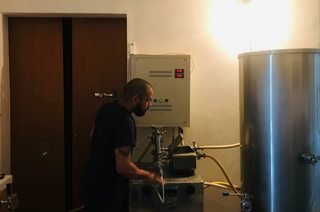
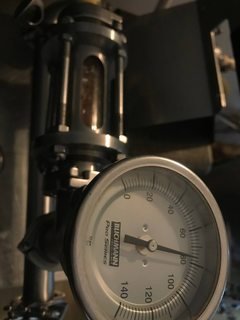
Ya estando el mosto en el fermentador a una temperatura menor a 28 grados, toca incorporar la levadura para que se alimente de los azúcares fermentables que obtuvimos en estapas previas y los conviertan en azucar, produzca CO2 entre otros subproductos.
Once the must is in the fermenter at a temperature below 28 degrees, it is time to incorporate the yeast to feed on the fermentable sugars obtained in previous stages and convert them into sugar, producing CO2 and other by-products.
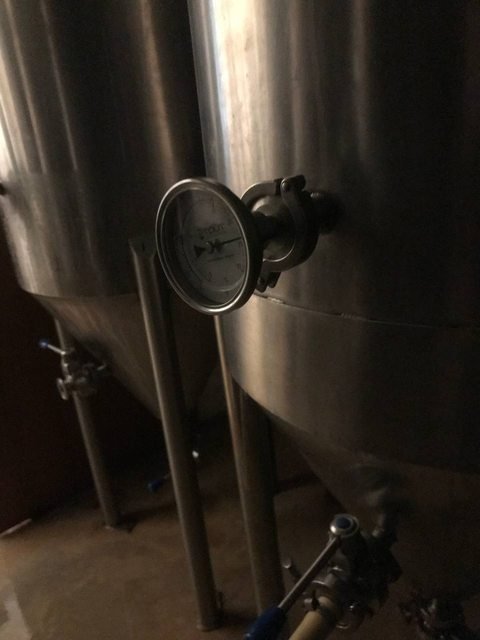
Al finalizar el día de trabajo lo que queda es limpiar todos los equipos utilizados, registrar todos los procesos realizados con sus variantes y disfrutar de una cerveza...
Porque nos lo merecemos!
At the end of the day's work what remains is to clean all the equipment used, record all the processes carried out with their variants, and enjoy a beer... Because we deserve it!
Because we deserve it!

Asi termina mi día como cervecero artesanal. Muchas gracias por haber leído hasta acá. También te mereces una cerveza!
Espero que les agrade mi contenido, cualquier sugerencia o pregunta sobre este tema con gusto las aceptaré.
Nos leeremos pronto!
Thus ends my day as a craft brewer. Thank you very much for reading this far. You deserve a beer too!
I hope you like my content, any suggestions or questions about this topic I will gladly accept them.
See you soon!
Salud! Prost! Cheers






















